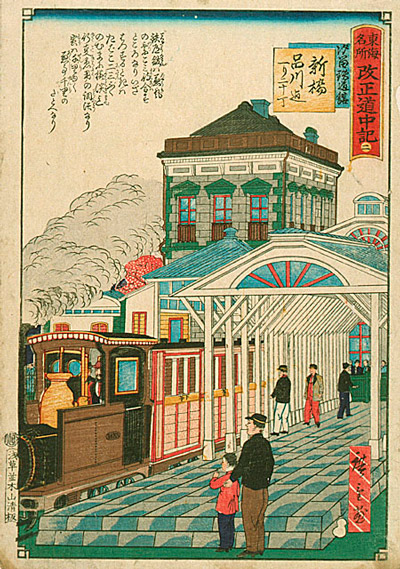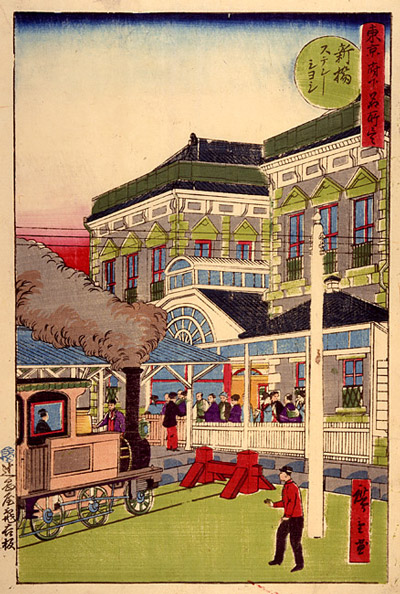About This Print
The artist designed at least nine prints (eight of which are shown below) commemorating the opening of the rail line from Tokyo to Yokohama in 1872. The nine prints show either Tokyo's Shimbashi Station (新橋駅) or Yokohama's station with a steam train either arriving, departing or parked. This print is from one of many different print series created by the artist titled Tokyo meisho (Famous Places of Tokyo.) (See this collection's print Tokyo meisho, First National Bank, IHL Cat. #994, for another print in this particular series.) This particular Tokyo meisho series is distinguished by its Western-style red and yellow frame, an artistic device for highlighting the modernity of the subject. This print falls under the genre kaika-e (pictures of modernization), more fully discussed below.
This particular series of prints is a low-budget production, with little care paid to registration and detail.
For another artist's rendering of the new rail line and steam train see Steam Train at Takanawa Seashore, Tokyo by Utagawa Yoshitora (fl. c. 1836-1882).
Source: The Hotei Encyclopedia of Japanese Woodblock Prints, Amy Reigle Newland, Hotei Publishing Company, 2005, volume 2, p. 243.
In one sense kaika-e served as a form of pictorial journalism. For example, among the most celebrated symbols of modernization was the train service initiated in 1872 between Yokohama and Shinbashi station (then known as Shiodome) in Tokyo. Eager to capitalize on the new subject matter, publishers had artists design train prints as soon as the plans were announced in 1870. In his 1875 triptych of Picture of the Steam Train Railroad Between Tokyo and Yokohama, Hiroshige III carefully details the train, the station and the Western clothing. The train almost seems like a toy from a fertile imagination, but the newly built station bears realistic Western architectural elements that are supported by contemporary photographs and correspond to details in many other prints of the station. Although the green and red trim on this stone building may appear incongruous to Western eyes, they must have pleased the print-buying public because similar colour adorns other versions of this frequently depicted structure.
Source: Meiji Revisited The Sites of Victorian Japan, Dallas Finn, Weather Hill, Inc. 1995, p. 45-46.
In the second year of Meiji (1869) the government decided to build a railroad. The actual railroad building was to be done by the British, so in the spring of 1870 the young British engineer Edmund Morell arrived to supervise railroad construction. (He died shortly after his arrival.) The engineers and the government deferred a direct route from Tokyo to Kyoto for a more practical 18-mile line from Tokyo to Yokohama. Beginning in 1870 at Yokohama, near the present-day Sakuragicho station, the builders laid a single track northward, reaching Kanagawa late in the year and Shinagawa by August 1872. By September 1872 the line had reached its terminus at Shinbashi, where an American architect, R. P. Bridgen, had already built a station in the style of the Gare de L’Est in Paris. (He built another stone faced wooden station just like it in Yokohama. Shinbashi Station was destroyed in the 1923 earthquake and was reconstructed in 2004.)
On 14 October 1872, the railway opened with great ceremony as the emperor took the first official ride. Though he arrived at Shinbashi in a Western carriage, he was dressed, probably for nearly the last time on such an occasion, in traditional court robes.
The new line, unlike early Western railroads, was more for people then for freight, and it attracted over a million and a half passengers by 1875, most of whom rode third class at thirty sen, though their betters paid sixty sen in second while foreigners and toffs put out one yen for a first-class ride.
latest revision:
| Shimbashi Station from Famous Places of Tokyo, c. 1872 | Shimbashi Station from Photographic Eight View of Tokyo, 1878 | Shimbashi Station |
Kaika-e (Pictures of Modernization)
Source: The Hotei Encyclopedia of Japanese Woodblock Prints, Amy Reigle Newland, Hotei Publishing Company, 2005, volume 2, p. 243.
In one sense kaika-e served as a form of pictorial journalism. For example, among the most celebrated symbols of modernization was the train service initiated in 1872 between Yokohama and Shinbashi station (then known as Shiodome) in Tokyo. Eager to capitalize on the new subject matter, publishers had artists design train prints as soon as the plans were announced in 1870. In his 1875 triptych of Picture of the Steam Train Railroad Between Tokyo and Yokohama, Hiroshige III carefully details the train, the station and the Western clothing. The train almost seems like a toy from a fertile imagination, but the newly built station bears realistic Western architectural elements that are supported by contemporary photographs and correspond to details in many other prints of the station. Although the green and red trim on this stone building may appear incongruous to Western eyes, they must have pleased the print-buying public because similar colour adorns other versions of this frequently depicted structure.
The Tokyo to Yokohama Rail Line
Source: Meiji Revisited The Sites of Victorian Japan, Dallas Finn, Weather Hill, Inc. 1995, p. 45-46.
In the second year of Meiji (1869) the government decided to build a railroad. The actual railroad building was to be done by the British, so in the spring of 1870 the young British engineer Edmund Morell arrived to supervise railroad construction. (He died shortly after his arrival.) The engineers and the government deferred a direct route from Tokyo to Kyoto for a more practical 18-mile line from Tokyo to Yokohama. Beginning in 1870 at Yokohama, near the present-day Sakuragicho station, the builders laid a single track northward, reaching Kanagawa late in the year and Shinagawa by August 1872. By September 1872 the line had reached its terminus at Shinbashi, where an American architect, R. P. Bridgen, had already built a station in the style of the Gare de L’Est in Paris. (He built another stone faced wooden station just like it in Yokohama. Shinbashi Station was destroyed in the 1923 earthquake and was reconstructed in 2004.)
On 14 October 1872, the railway opened with great ceremony as the emperor took the first official ride. Though he arrived at Shinbashi in a Western carriage, he was dressed, probably for nearly the last time on such an occasion, in traditional court robes.
The new line, unlike early Western railroads, was more for people then for freight, and it attracted over a million and a half passengers by 1875, most of whom rode third class at thirty sen, though their betters paid sixty sen in second while foreigners and toffs put out one yen for a first-class ride.
PowerPoint Presentation Notes from 1-31-2017 Presentation
Famous Places of Tokyo, First National Bank and Shimbashi Station, 1875
Among the most celebrated symbols of modernization was the train service initiated in 1872 between Yokohama and Shimbashi station in Tokyo. Eager to capitalize on the new subject matter, publishers had artists design train prints as soon as the plans were announced in 1870.
Prints depicting famous or scenic views, meisho-e, had a long history in woodblock prints. With the advent of the Restoration came new meisho-e depicting the new buildings, inventions and factories in a rapidly industrializing Japan. In these two prints we see the First National Bank an early pseudo-Western-style building erected in 1872. The cartouche contains the buildings vitals – height of 120 feet, frontage of 89 feet and depth of 167 feet. The bottom print commemorates the opening of the first train service connecting Yokohama and Tokyo.
Note the Western-style picture frame surrounding these prints.
PowerPoint Presentation Notes from 1-31-2017 Presentation
| Famous Places of Tokyo, First National Bank and Shimbashi Station, 1875 Among the most celebrated symbols of modernization was the train service initiated in 1872 between Yokohama and Shimbashi station in Tokyo. Eager to capitalize on the new subject matter, publishers had artists design train prints as soon as the plans were announced in 1870. Prints depicting famous or scenic views, meisho-e, had a long history in woodblock prints. With the advent of the Restoration came new meisho-e depicting the new buildings, inventions and factories in a rapidly industrializing Japan. In these two prints we see the First National Bank an early pseudo-Western-style building erected in 1872. The cartouche contains the buildings vitals – height of 120 feet, frontage of 89 feet and depth of 167 feet. The bottom print commemorates the opening of the first train service connecting Yokohama and Tokyo. Note the Western-style picture frame surrounding these prints. |
Print Details
| IHL Catalog | #352 |
| Title or Description | Famous Places of Tokyo, Shimbashi Station Tokyo meisho Shimbashi Stenshon 東京名所新橋ステンション |
| Artist | Utagawa Hiroshige III (1842–1894) |
| Signature |  |
| Seal | no artist's seal |
| Publication Date |  |
| Publisher |  |
| Carver | |
| Impression | good |
| Colors | excellent |
| Condition | good - minor wrinkling, small 1/8" tear to bottom margin; ink smudges in margins from printing process; margins untrimmed |
| Genre | nishiki-e; kaika-e; meisho-e |
| Miscellaneous | |
| Format | oban |
| H x W Paper | 9 1/2 x 14 1/4 in. (24.1 x 36.2 cm) |
| H x W Image | 8 5/8 x 13 in. (21.9 x 33 cm) |
| Literature | |
| Collections This Print | Art Gallery of Greater Victoria 2013.026.004 (bottom print) |
10/24/2020
3/27/2020












